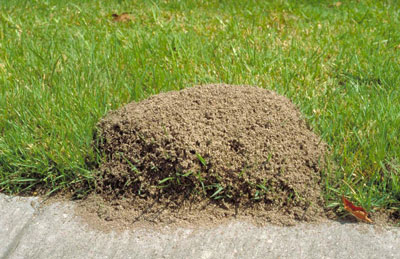Fire Ants Are Everywhere!
Fire ants have been in the United States since the early 1940s. They moved across much of Texas in the 70s and 80s, and now most of us have learned to watch for them as we work in our gardens.
That job becomes easier following heavy, saturating rains, because fire ant mounds pop up almost everywhere. They’re along walks, in gardens, around trees and mailboxes, and certainly out in the open as well.
These large mounds following rains are all about water tables. As the soil fills with water, the fire ants build their mounds higher and higher to save their colonies. The ants were there before, but they just become so much more obvious when they construct giant, cone-shaped mounds out of the ground.

Fire ant mounds like this are commonplace all over Texas right now – at least wherever fall rains have been heavy.
Control techniques…
How you deal with your fire ant visitors depends to some degree on where they have set up their mounds.
• Vegetable gardens… As you’re cleaning up rubble from this year’s garden crops you may encounter fire ant mounds. Read the label of any fire ant control product you’re considering carefully before you apply it where you’re growing edible crops. Extension entomologists suggest spinosad either as a drench or bait for use in vegetable gardens. Area-wide baits can be used outside the perimeter of the vegetable garden, but again, look for specific details on each product’s label.
• In turf… Nothing disrupts the beauty of a lawn faster than a big pile of fire ants. You may want to use a mound treatment to drench each individual outbreak, especially those that are near areas where people are likely to be. Follow that up a couple of days later with an area-wide bait product broadcast over the entire lawn and landscape.
• Where you have fire ants without visible mounds… Sometimes they just bite you from out of nowhere. If you want to be sure your yard has been rid of them before an event such as a garden wedding, broadcast fire ant granules across the entire area. It will provide a barrier that will prevent new mounds from forming, but unless it has a bait attractant in addition to the insecticide, it’s not going to be carried back to the mounds to kill the queens. Baits must work slowly enough to allow the workers to carry them back to share with others.
“So, should I treat now when the growing season is almost over?”
Yes. Extension entomologists tell us that if we limit fire ant populations now we will see far fewer come spring. Since fire ants are active all winter long, applying these products now while they’re near the soil surface makes all the sense.
Look for a Texas Certified, or Texas Master Certified Nursery Professional and ask his/her advice in choosing the right product for your specific needs.
Note 1: Think you have a home remedy for fire ant control? Better be careful. Click here to see what Texas A&M has to say on this topic.
Note 2: Want the full story on fire ants from Texas A&M entomologists? Here it is.
